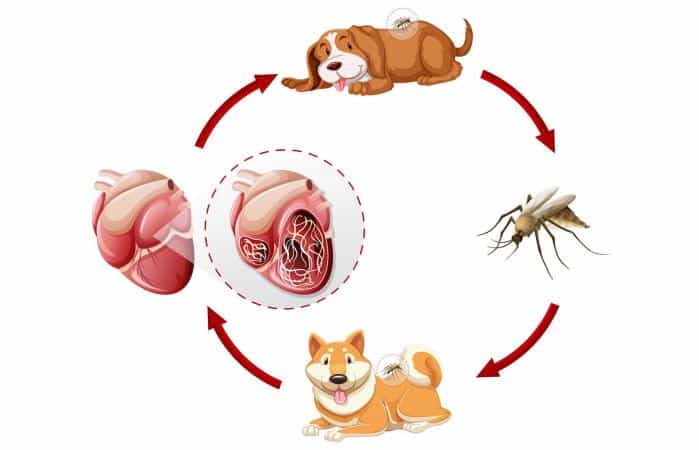Heartworm disease is a life-threatening disease that affects dogs, cats, and ferrets. When the disease reaches a critical stage, massive organ failure is inevitable, leading to death. The lungs and the heart are the most affected organs in the animal’s body.
The disease is caused by a parasite by the name Dirofilaria immitis. The dogs and other animals acquire this via misquote bites. The dogs act as the definitive host, meaning the worms mature and start reproducing in them. On the other hand, mosquitoes are the intermediate host. The parasites reside for a short duration in them before becoming infective.
Though the diseases are preventable, misconceptions about it can lead to fatalities; thus, the need to acquire life-saving information about heartworm disease and your dog.
In the US, the disease is more prevalent in The Gulf coast, such as the Gulf Coast of Mexico to New Jersey. It’s also present along the Mississippi River and the Atlantic.
This article will offer valuable information about the disease and how you can prevent it.
What is Heartworm Disease?
Heartworm disease is a disease that mainly affects pets and is spread by mosquitoes. The disease is caused by a parasite named Dirofilaria immitis. If not treated, the disease leads to death. It mainly affects the lungs, the heart, and the blood vessels.
According to information from the Food and Drug Administration (FDA), these parasites can live in the dog’s body for close to seven years and grow to about 4-6 inches for males and 10-12 inches for the female parasites.
How Does Your Dog Get Infected?
Dogs and other animals get infected via mosquito bites. The mosquito deposits microfilariae into the animal body which later develops into an adult parasite. In the host, the parasites continue to reproduce and increase in numbers.
Also, the Los Angeles County health department has reported the number of cases with dogs suffering from Heartworm.
How Will You Know Your Dog Has Heartworms?
The FDA classifies this disease into four stages. The initial stage may be asymptomatic.
Phase1: Though this stage in most cases is asymptomatic, a light cough may be present.
Phase2: This is the stage at which visible symptoms start to appear. Your dog may present with a cough, and it gets easily fatigued.
Phase3: The symptoms of heartworm disease are more pronounced at this stage. Your dog will experience a persistent cough, and it’ll tire after a light exercise. The dog may also present with breathing problems.
Phase 4: This stage is fatal if no action is taken. The stage is also known as caval syndrome. The worms have multiplied to large numbers, and they may block blood flow to the heart. At this stage, the dog requires immediate surgery or else it’ll die. Without swift surgery to clear the blockage, the dog will hardly survive.
Other signs that may show your dog is suffering heartworm disease include, weight loss, loss of appetite, inactivity, and general fatigue after exercise.
In advanced stages of the disease, heart and lung failure may result, and the dog will present with a swollen abdomen due to fluid retention in the belly.
If you observe any of the symptoms highlighted, you must visit your vet for proper diagnosis and treatment. The earlier you treat the disease, the better.
The Lifecycle of Heartworms in the Dog
When a dog is infected through a mosquito bite, these microfilariae grow and mature into adult worms. The female adult worms release microfilariae into the dog’s bloodstream. When a mosquito bites infected dogs, they will collect the microfilariae from the dog’s blood and get infected.
In 10-14 days, these microfilariae develop into infective larvae. It essential to note the microfilariae can’t become infective unless they get into a mosquito. The mosquito can now spread the larvae to healthy dogs and infect them via a mosquito bite.
Once these larvae are deposited into the healthy dog, they take 6-7 months to mature into adult worms. At this stage, the male and female worms mate and the female release microfilariae into the dog’s bloodstream and the cycle continues.
An infected dog can’t transmit these parasites to a healthy dog; the disease isn’t contagious; it spread only via mosquito bites.
The worms can live in the infected dog for 6-7 months. Mature heartworms take the shape of spaghetti. The males grow to a size of 4-6 inches while the female attains a length of 10-12 inches at maturity.
When referring to the degree of infection in a dog, we refer this to as the worm burden. Though the average worm burned in dogs stands at 15 worms, the figure ranges from 1-250 worms.

Diagnosis of Heartworm Disease in Dogs
Vets mainly diagnose heartworms through blood tests. The vet will draw blood from a suspected infected male and test for antigens. If a dog is infected by these worms, the female release these specific proteins known as antigens into the bloodstream.
Thus the vet will conduct an antigen test to confirm the presence or absence of these worms in a dog. The antigen test may be insensitive in the early stages of the infection. It’s probably at six months post-infection when the antigen will be present in the dog’s bloodstream.
Besides the antigen test, the vet can use another test to detect the presence of microfilariae in the dog’s bloodstream. Since it takes time for infective larvae to develop into adults, mate and release microfilariae into the bloodstream, your vet can only rely on this test six months after infection.
When to Test Your Dog for Heartworms
Since heartworm prevention doesn’t kill adult worms, it essential to test your dog before initiating preventive medicine. It’s critical to note that, your dog may appear healthy yet they are infected. Heartworm prevention targets the microfilariae.
Dogs that are more than 7 months of age should be tested for heartworm infestation before initiating preventive treatment.
To prevent heartworm disease, it’s essential to test your dogs every year. Talk with your vet for the best time to administer the treatment. If you administer preventive medicines to a dog that is already infected, you will only kill the microfilariae, and the adult worms will remain intact. This might lead to a shock reaction that can be fatal.
The timing and how offer you should test for heartworms varies depending on:
- When prevention is started
- Type of heartworm prevention medicine used
- The locality
- If the dog has traveled recently to a region where heartworms are prevalent
- How long the dog has missed heartworm medication
Frequency of Testing Dogs for Heartworms
You should test your dogs each year for heartworm infection. The best time to conduct these tests is during your regular visits to the vet for preventive care. These are common guidelines for testing dogs:
If your puppy is below 7 months of age, you can initiate heartworm prevention without testing for heartworm infection. This is because; it takes six months for microfilariae to develop into adults.
Thus a dog will only test positive for heartworms if they are tested six months after infection. After the preventive medication administration, the puppy should be checked after six months and then yearly.
- If your dog is over 7 months, and you’ve not initiated heartworm prevention, they must be tested before they are given any medication. After their first test, they should be re-tested after six months.
- If your dog had missed heartworm prevention for a while, you need to visit your vet for advice. Mostly, the vet tests the dog and re-starts the prevention instantly and then test the dog aster six months.
It’s essential to test your dog once per year if they’re on heartworm prevention. The testing is vital to know if the medication is effective. Though heartworm prevention is effective, some dogs still get infected even if they are on preventive medicine.
You may miss your monthly preventive dose or administer it late, thus exposing your dog to infection. Besides, your dog may vomit the medication without your knowledge. Therefore testing is crucial to establish if your dog needs treatment.
What Shall You Do if Your Dog Tests Positive for Heartworm Infection?
Confirm diagnosis
If your dog tests positive for heartworms, it’s essential to confirm the test through a different test since heartworm treatment is costly. Your vet must make sure; the dog is infected before initiating medication.
Minimize exercise
When your dog has been diagnosed with heartworm disease, you should limit their activity. This may not be easy, especially if your dog is very active.
Restricting movement is a safe way of managing the condition. Physical activity offers the parasites a better chance to damage the heart and the lungs. If your dog has severe symptoms, limit their movement. Your vet will give more advice on this.
Administer treatment
Your veterinarian will prescribe the right medication for heartworms. Make sure you adhere to the set schedule for compliance. The vet will prescribe medication depending on the severity of the disease and the prevailing symptoms.
Re-test
Six months after the administration of heartworm medication, your vet should test the dog to confirm all the heartworms have been eliminated from your dog’s body. Since your dog may contract the infection at any time even after mediation, heartworm prevention must be all year round.
Treatment of Heartworms
Melarsomine Dihydrochloride is the drug of choice for the treatment of heartworm disease. The molecule is available in the market in trade names such as Diroban and Immiticide. These drugs are to be administered for phases 1, 2, and 3 of the disease.
The FDA has approved this drug for the treatment of adult heartworms in dogs. This drug is administered an injection in the dog’s hind muscles.
The FDA has also approved, Advantage Multi for Dogs for the eradication of microfilariae in the dog’s bloodstream. This drug is administered as a topical application on the dog’s skin.
Treatment of heartworms is costly since it requires several visits to the vet, X-Rays, blood tests, and hospitalization. The mediation can also result in serious side effects on the dog, such as clots in the dog’s lungs.

Prevention is the Best Treatment!
Since treating heartworm disease is costly and may result in complications, especially at the advanced stages, prevention is the best treatment.
Medications used to prevent heartworm disease should only be administered under the prescription of a vet. Many of these drugs are available in the form of tablets or topically applied to the dog’s skin.
Some of the medications used to prevent heartworms are also effective against a majority of intestinal worms such as hookworms and roundworms. They will also work against other parasites like ticks, fleas, and ear mites.
Conclusion
If you have never made a visit to your vet for heartworm prevention, please do before your dog gets infected. The prevention should start at around seven months of age for the dogs.
For further reading on this top, also check FDA website.
Administering these preventive medications can save the life of your dog. Additionally, if your dog suffers any of the mentioned symptoms, visit your vet for proper diagnosis and treatment. Any time you miss administering the heartworm preventive medication, inform your vet.
References
Table of Contents




